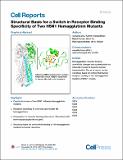| dc.contributor.author | Zhu, Xueyong | |
| dc.contributor.author | Viswanathan, Karthik | |
| dc.contributor.author | Raman, Rahul | |
| dc.contributor.author | Yu, Wenli | |
| dc.contributor.author | Sasisekharan, Ram | |
| dc.contributor.author | Wilson, Ian A. | |
| dc.date.accessioned | 2016-03-10T03:11:13Z | |
| dc.date.available | 2016-03-10T03:11:13Z | |
| dc.date.issued | 2015-11 | |
| dc.date.submitted | 2015-10 | |
| dc.identifier.issn | 22111247 | |
| dc.identifier.uri | http://hdl.handle.net/1721.1/101658 | |
| dc.description.abstract | Avian H5N1 influenza viruses continue to spread in wild birds and domestic poultry with sporadic infection in humans. Receptor binding specificity changes are a prerequisite for H5N1 viruses and other zoonotic viruses to be transmitted among humans. Previous reported hemagglutinin (HA) mutants from ferret-transmissible H5N1 viruses of A/Vietnam/1203/2004 and A/Indonesia/5/2005 showed slightly increased, but still very weak, binding to human receptors. From mutagenesis and glycan array studies, we previously identified two H5N1 HA mutants that could more effectively switch receptor specificity to human-like α2-6-linked sialosides with avidity comparable to wild-type H5 HA binding to avian-like α2-3-linked sialosides. Here, crystal structures of these two H5 HA mutants free and in complex with human and avian glycan receptor analogs reveal the structural basis for their preferential binding to human receptors. These findings suggest continuous surveillance should be maintained to monitor and assess human-to-human transmission potential of H5N1 viruses. | en_US |
| dc.description.sponsorship | Skaggs Institute for Chemical Biology | en_US |
| dc.description.sponsorship | National Institutes of Health (U.S.) (Merit Award R37 GM057073-13) | en_US |
| dc.description.sponsorship | National Institute of Allergy and Infectious Diseases (U.S.) (R01AI111395) | en_US |
| dc.description.sponsorship | Singapore. National Research Foundation (Singapore-MIT Alliance for Research and Technology) | en_US |
| dc.description.sponsorship | Skolkovo Foundation | en_US |
| dc.language.iso | en_US | |
| dc.publisher | Elsevier | en_US |
| dc.relation.isversionof | http://dx.doi.org/10.1016/j.celrep.2015.10.027 | en_US |
| dc.rights | Creative Commons Attribution | en_US |
| dc.rights.uri | http://creativecommons.org/licenses/by-nc-nd/4.0/ | en_US |
| dc.source | Elsevier | en_US |
| dc.title | Structural Basis for a Switch in Receptor Binding Specificity of Two H5N1 Hemagglutinin Mutants | en_US |
| dc.type | Article | en_US |
| dc.identifier.citation | Zhu, Xueyong, Karthik Viswanathan, Rahul Raman, Wenli Yu, Ram Sasisekharan, and Ian A. Wilson. “Structural Basis for a Switch in Receptor Binding Specificity of Two H5N1 Hemagglutinin Mutants.” Cell Reports 13, no. 8 (November 2015): 1683–1691. | en_US |
| dc.contributor.department | Massachusetts Institute of Technology. Department of Biological Engineering | en_US |
| dc.contributor.department | Massachusetts Institute of Technology. School of Engineering | en_US |
| dc.contributor.department | Koch Institute for Integrative Cancer Research at MIT | en_US |
| dc.contributor.mitauthor | Viswanathan, Karthik | en_US |
| dc.contributor.mitauthor | Raman, Rahul | en_US |
| dc.contributor.mitauthor | Sasisekharan, Ram | en_US |
| dc.relation.journal | Cell Reports | en_US |
| dc.eprint.version | Final published version | en_US |
| dc.type.uri | http://purl.org/eprint/type/JournalArticle | en_US |
| eprint.status | http://purl.org/eprint/status/PeerReviewed | en_US |
| dspace.orderedauthors | Zhu, Xueyong; Viswanathan, Karthik; Raman, Rahul; Yu, Wenli; Sasisekharan, Ram; Wilson, Ian A. | en_US |
| dc.identifier.orcid | https://orcid.org/0000-0002-1288-9965 | |
| dc.identifier.orcid | https://orcid.org/0000-0002-2085-7840 | |
| mit.license | PUBLISHER_CC | en_US |
